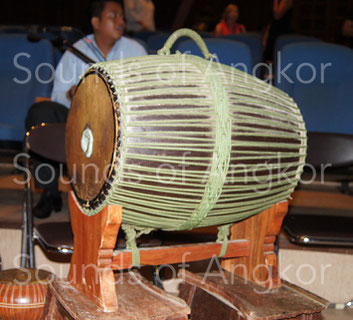Last update: December 5, 2023
Barrel drums are instruments whose diameter in the centre is larger than the diameter of the ends. Those of which we are speaking about are of small size, carried and played by the musician himself.
In general, these instruments are represented on bas-reliefs in real or mythological situations. They have two membranes each of which is supposed to produce a sound of different height. Their tension is achieved by a lacing system made of leather or vegetable fiber passing alternately by each of the skins. Traditional tuning is carried out either with movable wooden cylinders interposed between the tensioners and the drum, or with movable rings sliding along the links, or again with rice paste mixed with various Ingredients and stuck to the center of each membrane.
A high relief located to the north of the Terrace of Yama (also called 'of the Leper King') shows a knife-swallower accompanied by a woman striking a small barrel drum and another playing cymbals. The instrument is held by a strap passing around the hips.
On a lintel of Banteay Srei, a drummer animates the dance of God Śiva with two drums of different sizes placed vertically with a slight inclination. In this case, the two sound of different heights are produced by two distinct drums. These two instruments seem to take the place of the symbolic drum-rattle ḍamaru or ḍamarin, one of the attributes of Śiva.
In the north gallery of Angkor Wat (16th century), barrel drums of various sizes appear in play position: suspended around the neck with or without support, laid on the floor protected by their support. They are beaten with bare hands. Some show perfectly the lacing of the membranes, others not because the sculpture is sometimes purified.









